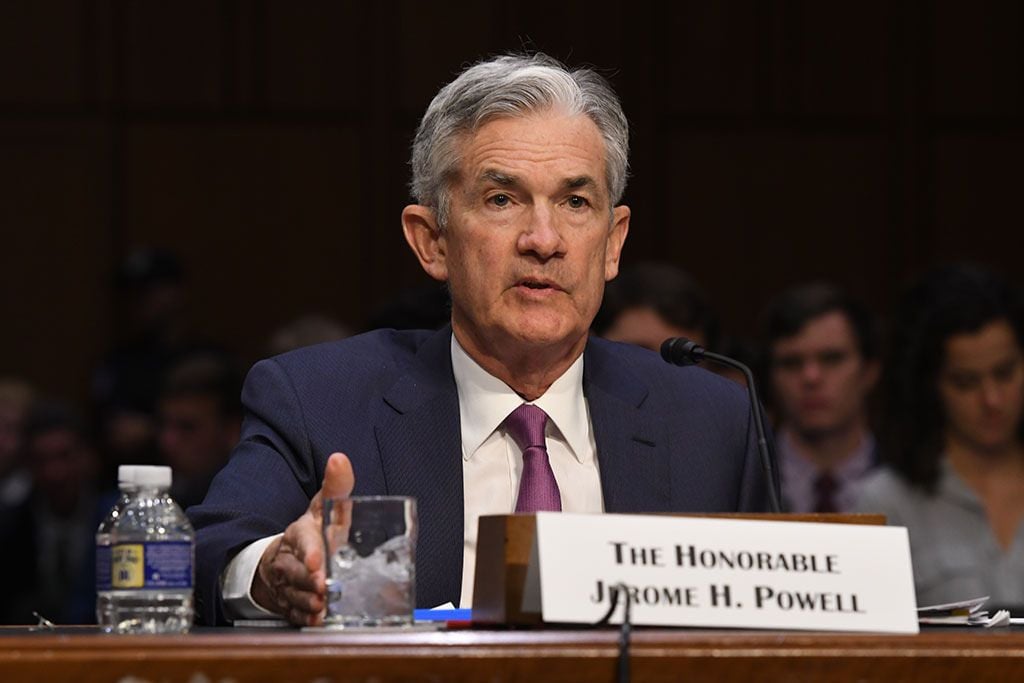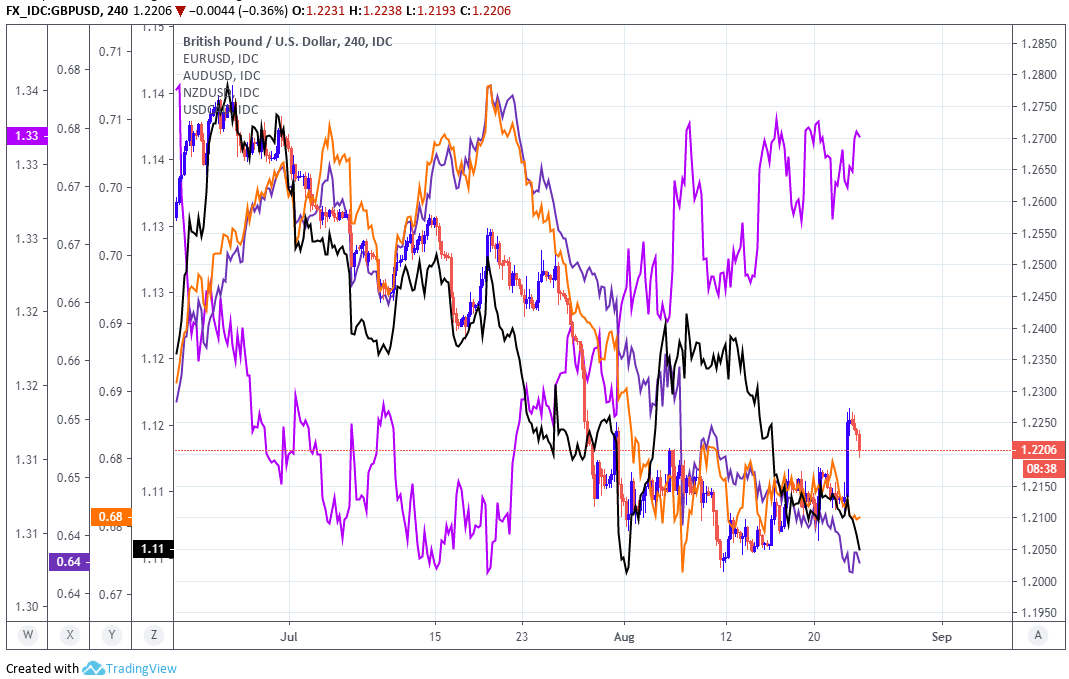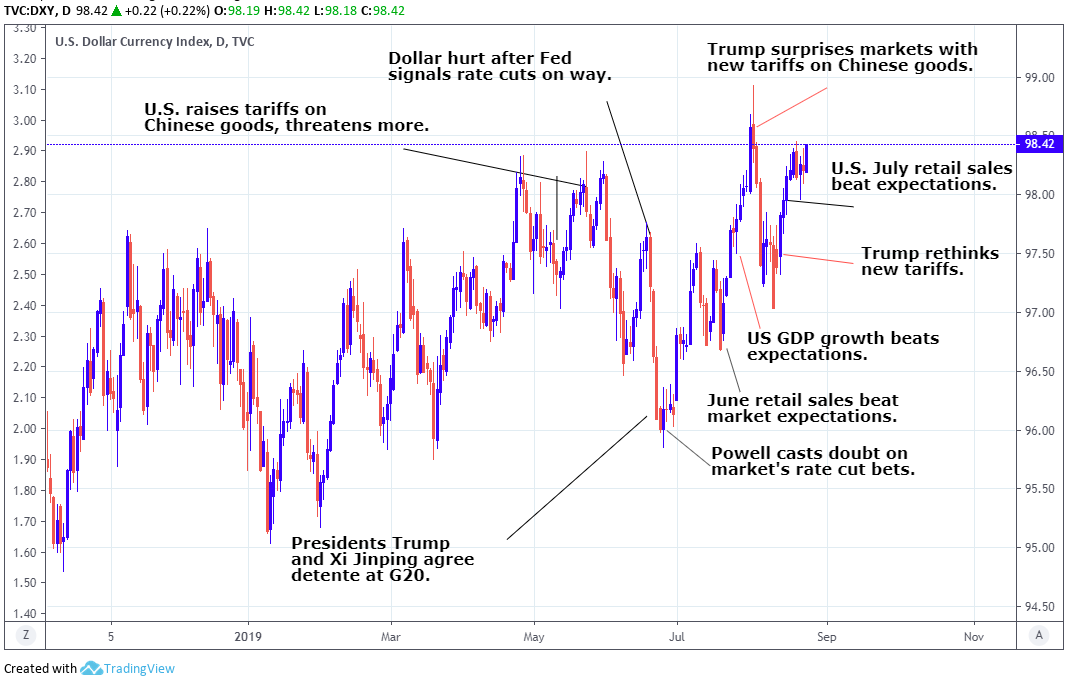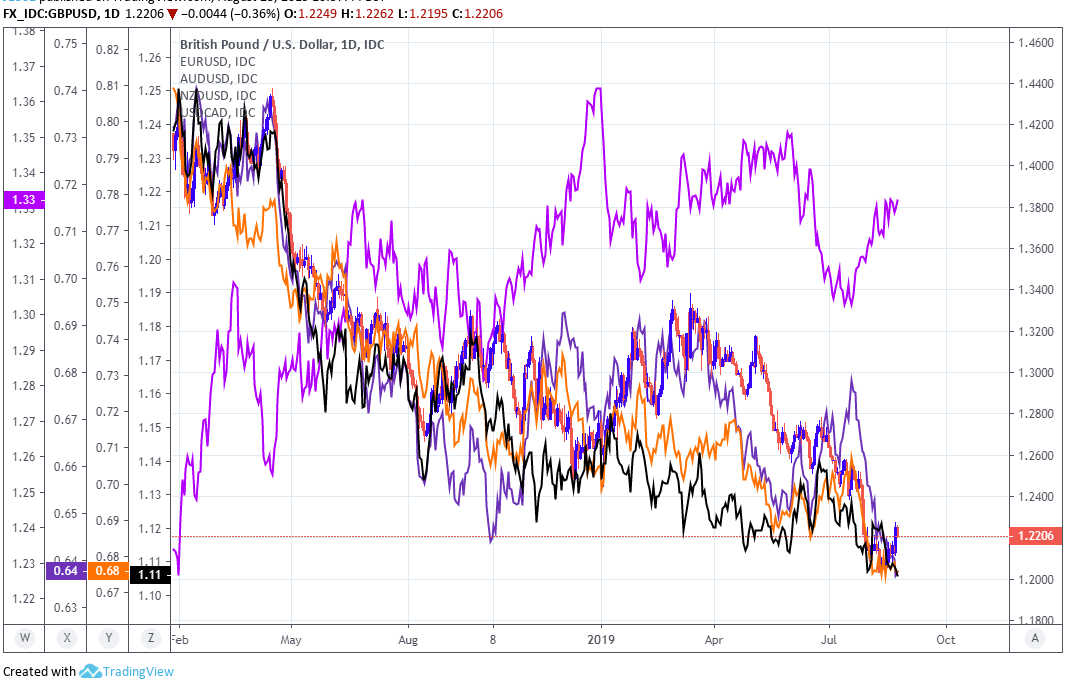The U.S. Dollar Marches Higher ahead of Powell Speech; Analyst Views
- Written by: James Skinner

Image © Federal Reserve
- USD marches north ahead of address from Fed's Powell.
- Analysts give views on Powell's likely tone and implications.
- GBP said to be at risk by Mizuho, AUD resists USD strength.
- NZD also resists USD as CAD tipped by TD for more gains.
- MUFG eyes a break above 98.40 for USD index post-Powell.
The Dollar was marching north Friday ahead of an eagerly-anticipated speech from Federal Reserve (Fed) Chairman Jerome Powell that will set the direction for major exchange rates for weeks to come, and analysts are increasingly warning the U.S. currency could strengthen further.
Jerome Powell will deliver a speech titled "Challenges for Monetary Policy" at the Jackson Hole Symposium conference on central banking at 15:00 London time Friday, and markets are tipped to throw a tantrum if the Fed chief doesn't indulge them and the White House by signalling that a shift in stance on interest rates is afoot. Fed rate policy has the potential to upset the established order in currency markets during the months ahead.
Investors have anticipated during recent weeks, that a mounting number of rate cuts will be delivered in the final months of the year in order to insure the economy against a possible downturn related to the trade war as well as slowing global growth. Pricing in the overnight-index-swap market implied on Thursday that the midpoint of the 25 basis point wide Fed Funds range would sit at 1.52% on December 11, the date of the Fed's final meeting for 2019 when it currently sits at 2.12%.
"Powell may get a GBP/USD sell off today. Some sense he will not be too dovish & buying are buying USD again," says Neil Jones, a managing director and head of corporates at Mizuho.

Above: GBP/USD rate at hourly intervals, with AUD/USD (orange, left), EUR/USD (black, left),
NZD/USD (dark purple, left axis) and USD/CAD (ligth purple, left axis).
The Dollar was higher against all G10 currencies other than the Australian Dollar and Norwegian Krone Friday, with the Pound-to-Dollar rate down 0.37% at 1.2205, as investors are buying the higher-yielding greenback in anticipation that markets will be forced to rethink the collective view of just how many rate cuts the Fed is likely to deliver this year. When the Fed cut rates from 2.5% to 2.25% on July 31, Powell characterised it as a "mid-cycle adjustment", not the beginning of an 'easing cycle'.
"Powell’s address will be his opportunity to offer a reassessment of the prospects for policy following the “mid-cycle adjustment” characterisation," says Adam Cole, chief FX strategist at RBC Capital Markets. "Powell will endorse expectations for further cuts going forward (and stress the end of QT is behind us already). But with markets already so aggressively priced, it would take a complete about turn from Powell to push rate expectations lower still and we think the balance of risks is USD-positive."
Fears on the FOMC have always been that a nascent global downturn will eventually hurt the U.S. through reduced demand for products made in America, although the Fed is constrained in the extent it can act by the elevated level of U.S. inflation and its statutory mandate to use interest rate policy to keep price pressures contained. However, since the July rate cut the context has changed notably, with the U.S.-China trade war flaring again and U.S. bond markets beginning to warn of recession.
"Markets are expecting another 50bps of Fed rate cuts by the end of the year. Even though we expect a dovish overall message from Chair Powell, it will likely fall short of the capitulation demanded by the market," says Lee Hardman, an analyst at MUFG. "The US dollar has been looking to break and stay above the 98.400 DXY level over the past week. It may get its opportunity today."

Above: Dollar Index shown at daily intervals and annotated for recent events.
Investors sold out of the U.S. bond market on Thursday, prompting two-year yields to rise over and above those of 10-year bonds and driving another inversion of the yield curve, which represents the cost of government borrowing for maturities between one month and 30 years. It inverts when short term bonds pay more than long-dated ones, which is the market anticipating that interest rates will be lower in the years ahead and is normally seen by analysts as a warning of recession. Selling continued on Friday.
"The market will be looking for signs that the Fed is willing to cut rates more than warranted by a "mid-cycle adjustment" in policy. Investors will also be watching for any signs of change in the Fed's inflation framework. We don't think that the Fed will provide much new information on either front," says Priya Misra, head of global rates at TD Securities. "We expect the Fed to ease by 75bp next year, but don't think that the Fed is likely to acknowledge that this is their base case just yet."
Yield curves have inverted and fears for the global economy risen ever since President Donald Trump said in early August that he intends to impose a 10% tariff on all of China's exports to the U.S. that are not yet covered by punitive levies. Some tariffs are scheduled to go into effect on September 01 and the rest on December 15, which will mean substantially all of China's trade with the U.S. is encumbered by one levy or another.
"Price action fatigue looks to be setting in USDCAD around the 200dma (~1.33). Given our expectations for Jackson Hole to disappoint, USDCAD's beta to rate spreads could be rekindled and help close the valuation gap relative to our HFFV estimate (~1.3150). We see this as a re-calibration to front-end rates rather than an inflection point for spot," says Mazen Issa, a currency strategist at TD Securities and colleague of Misra's.

Above: GBP/USD rate at daily intervals, with AUD/USD (orange, left), EUR/USD (black, left),
NZD/USD (dark purple, left axis) and USD/CAD (ligth purple, left axis).
For its part the U.S. economy has held up well when compared to peers elsewhere. Retail sales rose by a substantial 0.7% in July when the consensus had been for a stil-notable 0.3% increase. And sales already grew 0.3% in June when a pessimistic market had been looking for them to fall. Those figures suggest the U.S. consumer has not been deterred by either the trade war with China, or the four Fed rate hikes announced in 2018.
"At best, I would imagine a Fed hat-tip to those nasty trade wars, and how if they weren’t happening everything would have been perfectly fine, thank you very much. (Which isn’t true, but which will sell well with many who are desperate to hear it.) Moreover, it will be a case of Hole-y War if the market--or President Trump--doesn’t like what is said: if, for example, we get more Fed hawkishness," says Michael Every, a strategist at Rabobank.
Changes in rates are normally made in relation to the outlook for inflation, which is sensitive to economic growth, but impact currencies because of the influence they have over capital flows and decisions of short-term speculators. Capital flows tend to move in the direction of the most advantageous or improving returns, with a threat of lower rates normally seeing investors driven out of and deterred away from a currency. Rising rates have the opposite effect.
"Market participants will be watching the symposium for any signals of the Fed’s thinking ahead of the 19 September FOMC meeting, especially after the chorus of (albeit more hawkish) Fed members yesterday who sounded reluctant to cut interest rates further. We continue to expect the FOMC to cut interest rates by a further 25bp in September," says Kim Mundy at Commonwealth Bank of Australia. "Powell’s speech at the Jackson Hole Symposium today will determine if AUD/USD closes on its lows for the week or not. RBA Governor Phil Lowe is also speaking on a panel at Jackson Hole this weekend."
Time to move your money? Get 3-5% more currency than your bank would offer by using the services of foreign exchange specialists at RationalFX. A specialist broker can deliver you an exchange rate closer to the real market rate, thereby saving you substantial quantities of currency. Find out more here.
* Advertisement




